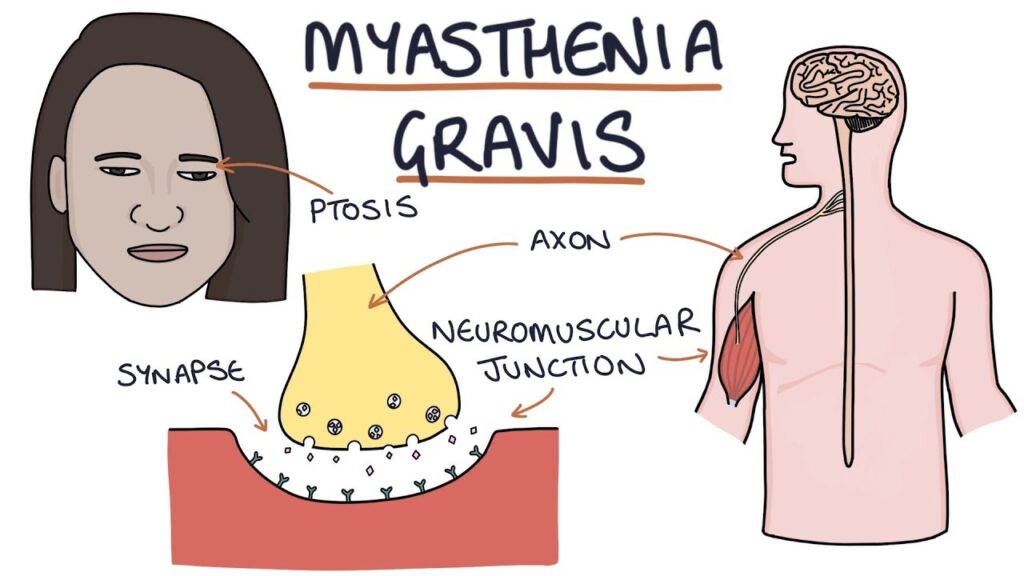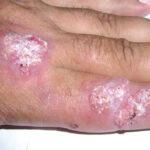Myasthenia gravis (MG) is a chronic autoimmune neuromuscular disorder that leads to varying degrees of skeletal muscle weakness. This condition occurs when communication between nerves and muscles is disrupted due to the body’s immune system attacking acetylcholine receptors at the neuromuscular junction. Early diagnosis and effective treatment are crucial for managing symptoms and improving quality of life.

Understanding Myasthenia Gravis
Myasthenia gravis is characterized by muscle weakness that worsens with activity and improves with rest. The disorder primarily affects voluntary muscles, including those responsible for eye movement, facial expressions, chewing, swallowing, and breathing.
Pathophysiology of Myasthenia Gravis
The immune system produces autoantibodies that block or destroy acetylcholine receptors, preventing effective nerve signal transmission to muscles. This results in muscle fatigue and weakness, which can become severe in advanced cases.
Causes and Risk Factors
1. Autoimmune Response
Myasthenia gravis is caused by an abnormal immune response where the body mistakenly attacks acetylcholine receptors or associated proteins.
2. Thymus Gland Abnormalities
- The thymus gland, which plays a role in immune function, is often enlarged in MG patients.
- Thymomas (tumors of the thymus) can contribute to MG development.
3. Genetic and Environmental Factors
- Although MG is not directly inherited, genetic predisposition may increase susceptibility.
- Viral infections or environmental triggers may contribute to disease onset.
4. Drug-Induced Myasthenia Gravis
Certain medications can trigger or worsen MG symptoms, including:
- Beta-blockers
- Calcium channel blockers
- Aminoglycoside antibiotics
- Magnesium-containing drugs
Signs and Symptoms of Myasthenia Gravis
The symptoms of MG vary in severity and may fluctuate throughout the day.
1. Ocular Symptoms
- Ptosis (drooping eyelids)
- Diplopia (double vision)
2. Bulbar Symptoms
- Difficulty swallowing (dysphagia)
- Impaired speech (dysarthria)
- Weakness in chewing muscles
3. Generalized Muscle Weakness
- Fatigue that worsens with activity
- Weakness in the arms and legs
- Respiratory muscle weakness in severe cases
4. Myasthenic Crisis
- A life-threatening complication involving severe respiratory weakness requiring immediate medical intervention.
Diagnosis of Myasthenia Gravis
Diagnosing MG involves clinical evaluation and specialized tests to confirm neuromuscular dysfunction.
1. Neurological Examination
- Assessment of muscle strength and reflexes
- Fatigability tests (e.g., sustained upward gaze)
2. Antibody Tests
- Acetylcholine receptor (AChR) antibody test
- Muscle-specific kinase (MuSK) antibody test
3. Electromyography (EMG)
- Repetitive nerve stimulation test to detect impaired neuromuscular transmission.
4. Edrophonium (Tensilon) Test
- Short-acting drug to temporarily improve muscle strength, confirming MG diagnosis.
5. Imaging Studies
- Chest CT or MRI to detect thymomas.
Treatment and Management of Myasthenia Gravis
While there is no cure for MG, various treatment options help manage symptoms and improve muscle function.
1. Medications
- Cholinesterase Inhibitors (e.g., Pyridostigmine): Improve nerve-muscle communication by increasing acetylcholine levels.
- Corticosteroids (e.g., Prednisone): Suppress immune response and reduce autoantibody production.
- Immunosuppressants (e.g., Azathioprine, Mycophenolate mofetil): Used in severe cases to control autoimmune activity.
2. Plasma Exchange (Plasmapheresis) and Intravenous Immunoglobulin (IVIG)
- Removes circulating antibodies or provides immune-modulating effects during myasthenic crises.
3. Thymectomy
- Surgical removal of the thymus gland can improve symptoms, especially in patients with thymomas.
4. Lifestyle and Supportive Care
- Energy Conservation: Pacing activities to prevent muscle fatigue.
- Speech and Swallowing Therapy: Assistance in managing bulbar symptoms.
- Respiratory Support: Non-invasive ventilation for severe cases.
Prognosis and Long-Term Outlook
With proper treatment, most MG patients lead productive lives. However, symptom severity and progression vary:
- Mild to moderate cases can be managed with medication and therapy.
- Severe cases may require long-term immunosuppression or assistive breathing devices.
Myasthenia gravis is a complex autoimmune neuromuscular disorder that requires early diagnosis and effective treatment to manage symptoms. Advances in medical therapies and surgical interventions have significantly improved the prognosis for MG patients, allowing them to maintain a good quality of life.

